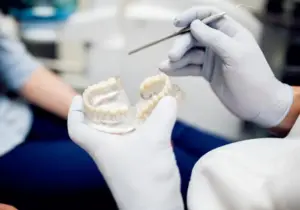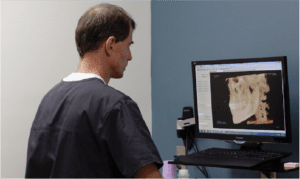What are the most common methods of tooth replacement? There are a number of options available — dental implants, bridges, dentures, even a combination of all three for a full mouth reconstruction. Each has its own advantages, and different patients may find one a better fit than another. A beautiful smile is important to your health and happiness; replacing missing teeth should be a priority. And believe it or not, oral surgeries and tooth replacement can be simple, painless and affordable.
What you should absolutely not do is to just ignore empty space in your smile. Not replacing a missing tooth can have devastating effects on the rest of your mouth. You can risk displacing neighboring teeth, suffer bone loss in your jaw, or even suffer a facial structure collapse. Not to mention that having an empty slot in your smile can hurt your self-esteem and your mental well-being.
Missing teeth can impact not only how you look, but how well you’re able to eat, speak, and even breathe, in some cases. That’s why it’s so important to work with a dentist or oral surgeon to replace a missing tooth as soon as the tooth has been lost or extracted.
There are several approaches a maxillofacial surgeon can take to reconstruct a mouth, but there are 3 methods of tooth replacement our patients commonly choose:
- Dentures: Removable tooth installations
- Dentures are the most affordable solution to missing teeth. They restore the appearance and function of your bite. They are removable and semi-permanent. Since they don’t actually interact with your jaw bone at all, your jaw will still continue to change, so dentures will stop fitting eventually and need replaced.
- Partial dentures are used if you still have some teeth remaining but your jaw isn’t healthy enough for a dental implant or a bridge.
- Full dentures are held in via suction and are used after all unhealthy teeth are extracted and the gums and jawbone have had time to heal. Today’s dentures are custom-fit to be comfortable, secure, and appear natural.
- The All-on-4® dentures combine dental implant technology with dentures to create a better denture. This type of oral procedure is a good option for people who don’t have enough jaw bone to take a full set of dental implants, but want something less temporary and lower-maintenance than traditional dentures.
- Bridges: Semi-permanent dental prosthetics
- Traditional tooth-anchored bridges are made to span an area of missing teeth. The oral surgeon files down teeth on one or both sides of the bridge so it can be fitted over them and anchored in place. This type of bridge may or may not be removable.
- Bridges can act as a tooth replacement option or as a stop-gap for dental implant surgery. We don’t recommend children get dental implants, as their jaw is still growing and changing. And while we do specialize in pediatric oral surgery, we find that waiting for dental implant surgery until a child is grown is the best way to holistically replace their missing teeth. As a result, we often treat children with missing adult teeth via tooth-anchored bridges or partial removable dentures.
- Implant-supported bridges are used when you don’t have enough teeth or strong enough teeth to support a bridge, and are basically a large and permanent dental implant, usually anchored to your jaw or your cheekbones. An implant-supported bridge is more affordable than a row of several separate implants.
- If you just have loose teeth from facial trauma or gum disease that need anchored while the bone and gums are healing, sometimes a doctor will install a bonding bridge behind all the teeth to keep them in place while they heal.
- Dental Implants: Permanent oral installations/tooth replacement
- Dental implants are fake teeth with artificial “roots” that, after installed, fuse with the jawbone and essentially become a part of your mouth. They are the most expensive option for replacing teeth, but they’re permanent and comprehensive.
- Patients have to have enough jaw bone integrity to take a dental implant. An oral surgeon can do some dental bone grafting to augment the jaw, but the patient still needs enough bone material and density to properly integrate with the dental implants.
- You can choose from titanium or zirconia dental implants. Zirconia dental implants are typically used for people who are allergic to metal, or who want more “holistic” tooth replacement, as zirconia is a ceramic and not a metal. Dental implants look, function and feel just like real teeth once they’re healed, and they require no maintenance beyond normal oral hygiene and regular dentist visits.
- Dental implant surgery requires significant healing time. Some patients with good jaw health can get same day dental implants, which streamlines the process, but as this is an oral surgery, healing time is just a reality.
The right tooth replacement choice for you depends on your budget and insurance considerations, as well as health needs and preferences. Obviously, some are more invasive than others, and the extent of your needs as well as how your insurance handles cosmetic vs restorative oral surgeries and procedures will affect which solutions we advise.
Let’s get into a little more detail on some of our most common tooth replacement options:
Removable Partial Dentures: Affordable Aesthetics
As the name implies, dentures are removed at night and for cleaning. Partial dentures will include replacement teeth attached to a plastic base that matches the color of your gums. It usually contains a clasp to attach to your natural teeth that surround the missing ones.
Dentures take some time getting used to. It may take several weeks before they feel completely comfortable. Overtime, the bones of your jaw may adjust to the area where the teeth are missing, causing your dentures to not fit as properly.
You’ll need to regularly have your dentures inspected by a dentist. You’ll also need to care for the dentures and your remaining teeth properly to mitigate any further tooth loss, gum or jaw damage.
Best for: Cost-effective tooth replacement
Main drawback: Need refit/replaced often
Dental Bridges: The Middle Ground of Tooth Prosthetics
You can replace a tooth or set of teeth with a fixed bridge that fills the space where one or more teeth have been lost. The bridge is cemented or bonded in place — it can only be removed by your dentist or oral surgeon. Sometimes a maxillofacial surgeon will attach the bridge with a dental implant or two, which extends the capabilities and life of the bridge.
We typically place bridges over several appointments, taking great care to find the perfect fit so the bridge looks, fits and works naturally in your mouth.
Best for: Pediatric tooth replacement, several missing teeth
Main drawback: Semi-permanent
Dental Implants: Holistic Tooth Restoration
By far, the best choice for tooth replacement is a dental implant. They are a permanent solution to missing teeth. Dental implants can be used to replace one tooth or to do a full mouth reconstruction, if necessary. The implant is surgically drilled into your jaw bone to eventually become just as functional as your natural tooth.
Dental implants are the ideal way to replace a tooth — but also the most expensive. After healing time, you’ll have a completely functional tooth that does not have to be removed and is attached to your jaw, just like a natural tooth. Usually the screw drilled into your jaw for this type of tooth replacement is titanium, because your jawbone can fuse directly to the surface of titanium.
Dr. Puckett also offers a newer type of dental implant: zirconia implants — the only fully ceramic system on the market. These dental implants are highly versatile and look beautiful. Ceramic dental implants also eliminate the risk of the dark line at the gums that titanium dental implants sometimes cause.
Best for: Permanent reconstruction
Main drawback: Expensive
Let’s Discuss Your Options for Tooth Replacement!
Nobody likes to lose a tooth. And certainly, financial considerations will guide your plan to replace it. That’s why we like to present your options openly. And it’s also why we take purposeful steps throughout any treatment process to cut costs for our patients while maintaining the highest level of care. Dr. Puckett is an oral surgeon who prioritizes the care of his patients with open and honest conversations about their oral care and budget needs.
Replacing lost teeth is a sensitive issue — one you’ll have to live with for a long time. We’ll discuss your options and develop a sequencing plan for all the dental implants or prosthetics you’ll need. We’ll share this copy with you and give you some time to think about it. As a maxillofacial surgeon who specializes in dental implants, Dr. Puckett believes in empowering our patients so they can make informed decisions when it comes to what’s best for their oral care.









